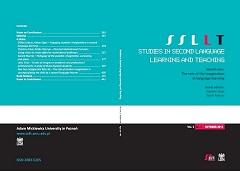The role of a teacher imagination in conceptualising the child as a second language learner
The role of teacher imagination in conceptualising the child as a second langauge learner
Author(s): Ewa Guz, Małgorzata TetiurkaSubject(s): Language and Literature Studies
Published by: Wojskowe Biuro Historyczne im. gen. broni Kazimierza Sosnkowskiego
Keywords: young learners; cognitive development; teacher beiefs; teacher cognition; imagination
Summary/Abstract: In order to initiate and maintain meaningful interaction in a young learner L2 classroom, an adult teacher needs to approach children in ways consistent with their developmental profile and adjust teaching methodology so as to accommodate young learners' current skills. This requires the ability to predict the child's possible responses to classroom events by imagining what s/he might think and how s/he might behave when presented with specific instructions. Bearing in mind that the teacher's perception of the world is purely and completely adult in nature, in order to be effective, educators need to create a mental image or a concept of a young learner by gathering knowledge about his or her developmental characteristics and fully grasping the pedagogical implications of this knowledge. In this paper, we aim to explore the role of imagination in the conceptualisation of a child as a second language learner amongst univeristy level pre-service teachers involved in an early primary EFL education programme. We report on qualitative research based on data obtained in the course of a two semester teacher trainingcourse of 35 BA and 30 MA students majoring in English. In the study, we focused on the working image of the child's developmental characteristics created by the participants and their ability to employ this in their teaching. Our data show a substantial discrapancy between the participants' theoretical conceptions concerning the business of teaching and the actual actions undertaken during lessons with young learners. Although participants were able to successfuly identify the most distinctive developmental characteristics of primary-level learnrs, they experienced difficulty with integrating them into actual classroom practice.
Journal: Studies in Second Language Learning and Teaching
- Issue Year: III/2013
- Issue No: 3
- Page Range: 419-439
- Page Count: 20
- Language: English

